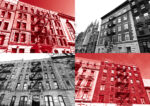As struggling landlords scramble to unload rent-stabilized buildings before the bank comes calling, a recent sale shows just how big a haircut some are willing to take.
Barberry Rose Management sold 16 rent-stabilized buildings for $47 million this month. The properties span Sherman, Post and Vermilyea avenues in Inwood and include 519 West 143rd Street and 574 West 161st Street in Washington Heights.
The brokers on the deal, Cignature Realty’s Lazer Sternhell and Peter Vanderpool, said the sale took “a bit longer than expected,” but ultimately, Barberry Rose and buyer Coney Realty, settled on a “good price.”
These days, a good price for a rent-stabilized portfolio pencils out to a 44 percent discount. Barberry Rose, headed by Lewis Barbanel, bought the buildings for $83.6M in 2016, property records show.
“That’s just a reflection of where the market is,” Sternhill said.
Barbanel tied the decision to sell to “three black swan events” that “made it impossible to hold the asset”: the 2019 rent law, the pandemic and rate hikes.
The 2019 rent law blocked nearly every route to boost revenues. In the years since, expenses have ballooned and the rent guidelines board’s annual rent adjustments — the only increase available to owners — have consistently lagged the rising cost of doing business.
Barbanel in 2023 testified before the rent guidelines board, detailing the hit to cash flow.
“There are many rent-stabilized units whose rent doesn’t even cover its own share of these basic costs,” he said.
The pandemic decimated rent rolls. Across Barbanel’s Inwood portfolio, the owner has filed 54 eviction suits, most for nonpayment, since the moratorium expired in January 2022.
The landlord also got stuck with a number of vacant apartments slotted for renovations when the rent law changed. The legislation capped the recoupable cost of upgrades, rendering many projects unfeasible.
Barbanel said his portfolio-wide rent collections now average 80 percent.
For owners with maturities approaching, rising rates have dealt the final blow. Lenders are often unwilling to refinance loans tied to distressed buildings. Owners of buildings that are still squeaking by may be unable to shoulder costlier debt payments once they refinance in a higher-rate environment.
Amid that mass of misfortunes, foreclosure filings are mounting. City Skyline Realty saw four foreclosures in September. New York Community Bank doled out eight to two owners in August.
Barberry Rose wasn’t struggling with loan payments — yet. The sponsor financed the portfolio with low leverage debt, property records show.
Rather, his exit was a move to salvage what equity was left in the deals before the market gets worse or his loans mature. Of the buildings Barbanel offloaded, most had debt coming due.
Industry observers say a growing number of rent-stabilized owners are deciding to cut and run. Some are getting out of New York altogether.
Read more



Jay Martin, who heads landlord group the Community Housing Improvement Program, said one owner folded a 60-year business “just to cover their loans.”
“Ten-building portfolio, walked away with nothing, moved to Florida,” Martin said.
Barbanel isn’t there yet.
“I’m still a New York operator; we are committed to New York,” he said. “But I cannot buy rent-stabilized buildings in New York City until the laws change.”
